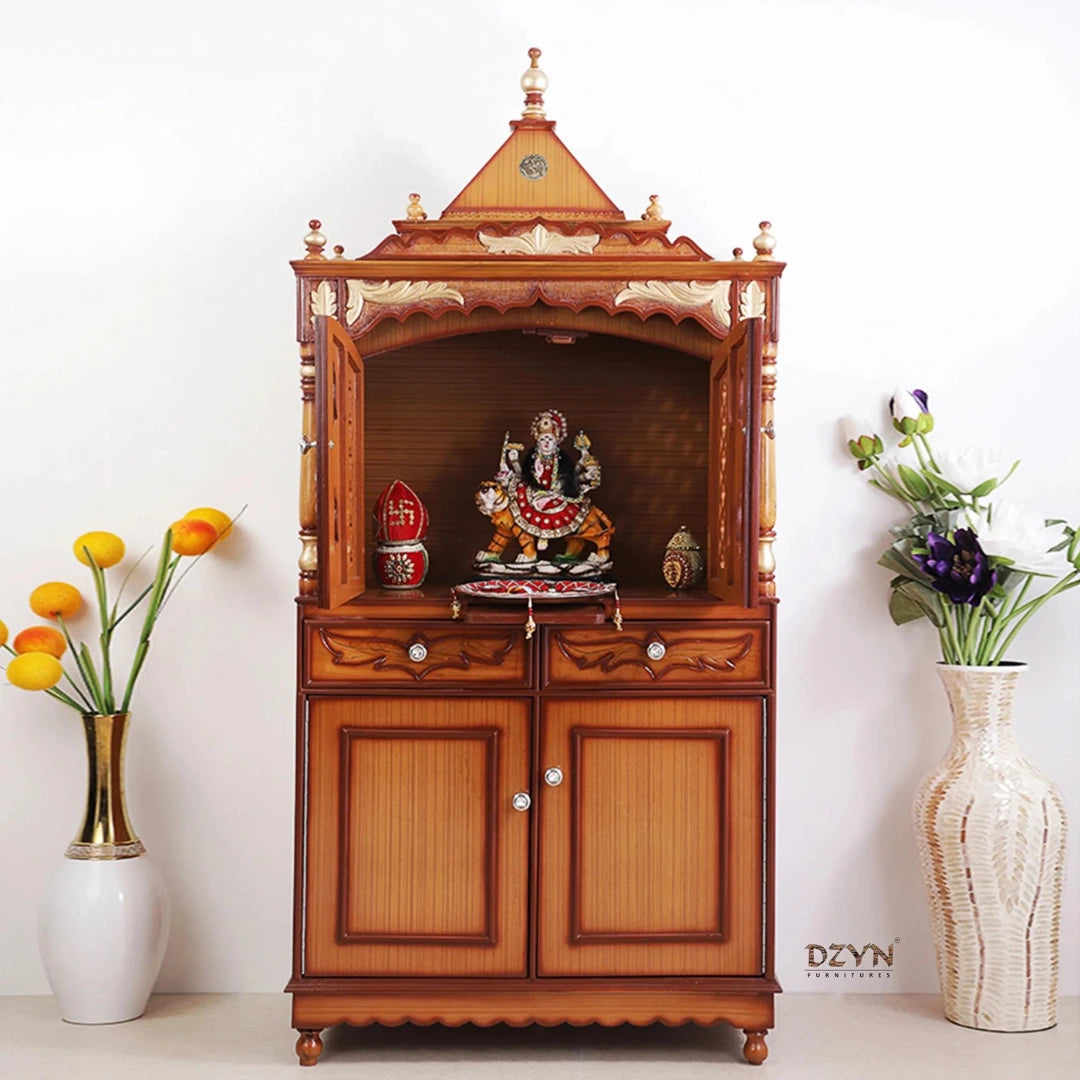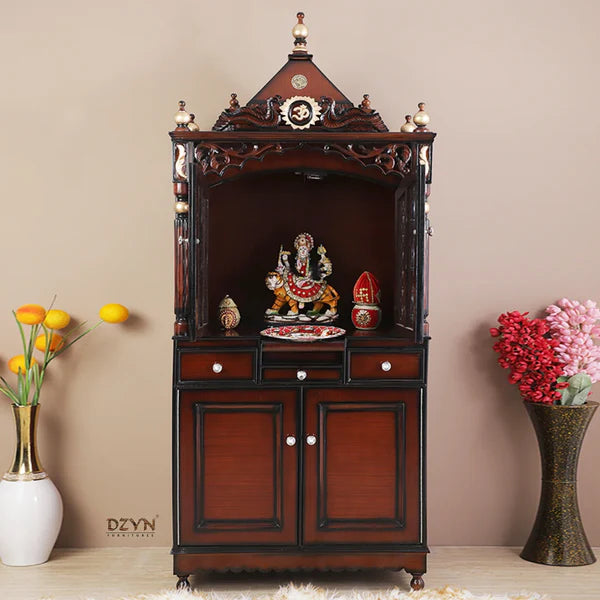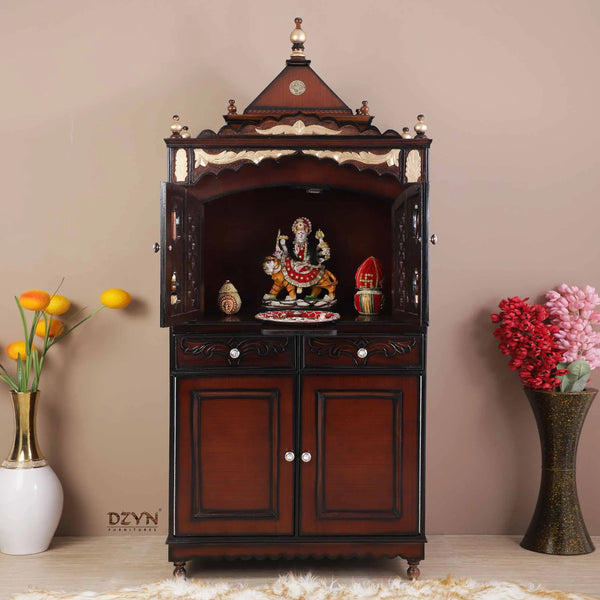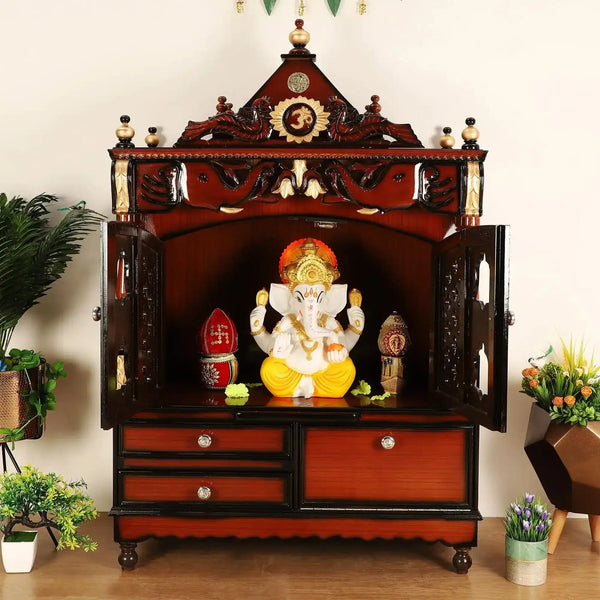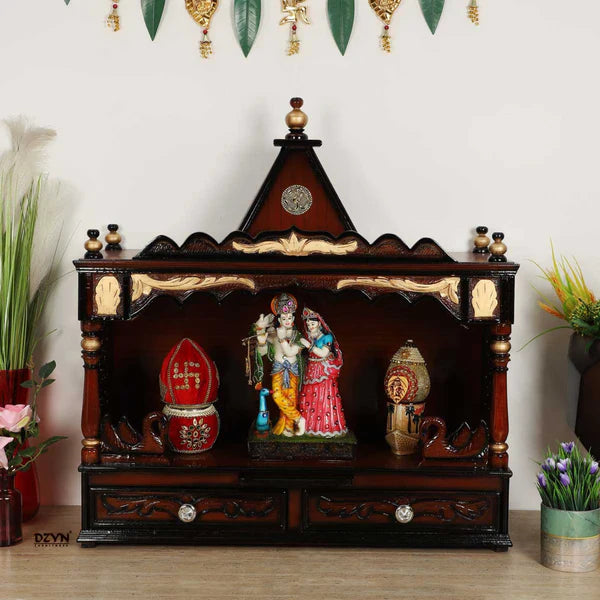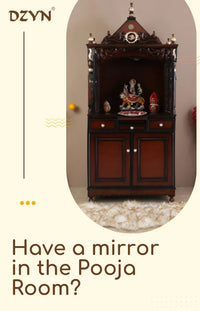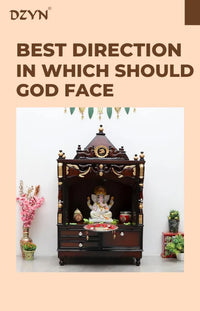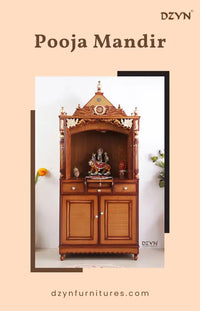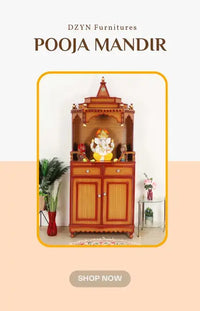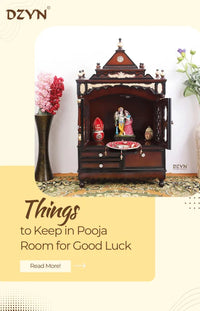In Hindu culture, the direction in which we place the idol of god in our home temple holds deep significance. Each direction is believed to carry its own spiritual meaning, due to this reason it is essential to create a peaceful and harmonious space for worship. Around the world, many cultures place importance on the direction a god faces. Because it is crucial for attracting peace, prosperity and spiritual well-being. However, some specific directions are reserved for certain rituals like cremation rituals. So we should avoid placing idols in those directions. Positioning god direction in home is not just a cultural practice, but a belief rooted in our Hindu culture, science and even physiology all across the globe.
Understanding Vastu Shastra Principles for Placing Deities
What is Vastu Shastra?
Before placing idols in a wooden mandir for home, it's important to consider the traditional designs rooted in ancient Indian architecture. Vastu Shastra is an ancient Indian science of Architecture. For centuries, we have been constructing our temples and homes following the principles of Vastu Shastra. This holds significance for many people due to its impact on various aspects of our lives that also include spiritual harmony. Here are some recommended directions from the Shastra for your home temple:
Northeast (Ishanya) the best direction: The northeast direction which is also known as the “Ishanya” corner, is the most auspicious location for placing deities and setting up a home temple. This god direction as per vastu in our culture is considered sacred because it is associated with clarity, enlightenment and divinity. When a god faces the northeast direction, it symbolizes the channelling of pure vitality and spiritual growth in the home. These energies can benefit the people living in the house. Placing a home temple in this direction is believed to help improve concentration and create an atmosphere conducive to prayer.
Why Northeast?
The northeast direction receives early morning sunlight, which carries a natural, cleansing energy that supports spiritual practices in the mandir for home. This direction is linked to Jupiter and in Vastu astrology Jupiter is known as the planet of wisdom, knowledge and higher spirituality. So the god direction in home aligns with Jupiter's qualities. A northeast-facing deity is said to bring blessings, health and mental peace to the home temple.
Alternatives if the northeast is not available: In the modern home temple, the northeast direction may not always be accessible because of the limited space. In such cases, Vastu suggests that placing deities to face east direction is a favorable alternative for god direction as per vastu.
East facing pooja mandir for home: East is associated with the sun and energy which symbolizes new beginnings, warmth and growth. These are the positive attributes for pooja mandir for home.
West or North-facing Options: If northeast or east-facing placements are not possible, you may choose west or north directions. It is necessary to maintain a clean, clutter-free environment around the mandir for home.
Why These Directions Matter: Both the northeast and east directions receive early morning sunlight, which is linked to cleansing, positivity and new beginnings. If you place your mandir for home in these directions, it fosters harmony, peace and focus during prayer.
Traditional Beliefs and Practices Beyond Vastu
Feng Shui and eastern beliefs: Feng Shui is an ancient Chinese practice that revolves around the placing of objects, buildings and certain things in a particular arrangement so that it will bring harmony and balance. While Feng Shui does not specifically tell us which direction is the god direction in home, it emphasizes creating balance, spirit flow and harmony within a space. Feng Shui practitioners recommend aligning idol placements in proportion with elements like water and fire and they often place statues near entrances of the shrine or windows to promote positive energy circulation.
Comparative practices across cultures: In many Western homes, direction plays less of a role in placing religious symbols and the emphasis is more on having a dedicated, respectful wooden mandir for home. This can be a shelf, a corner or even a small room, which focuses on maintaining a smooth environment rather than sticking to strict directional guidelines. 
Scientific Perspectives on Direction and Energy Flow
Magnetic fields and energy in the home: The direction a deity faces can also be influenced by the Earth’s natural magnetic fields, which some cultures believe, impact the home’s energy flow and can affect one’s concentration and peace during meditation. The northeast, in particular, is said to be a good direction as per vastu, and is seen as having beneficial energy because it aligns well with the magnetic north. This alignment can positively influence how people feel and think when facing this direction during prayer. Setting a mandir for home in this direction is advisable.
Natural light and airflow: Positioning god direction in home that receives natural light, such as east or northeast, can enhance the worship space's ambiance which makes it feel more open, welcoming and alive during the prayers in the home temple. Sunlight brings positivity and health benefits which makes the home temple a brighter and better place for meditation or prayer.
Psychological effects of direction in worship: The orientation of god direction in the home can have a small but significant psychological impact on individuals and in pooja mandir for home. Facing east or northeast while meditating or praying can make you feel more connected with the natural rhythms of the day. This promotes peace and recharging throughout the day. Some psychologists suggest that the act of aligning yourself with natural directions during prayer can foster a feeling of grounding and connectedness. It can boost positive habits that support mindfulness and well-being.
Decorating the Mandir for Home to Enhance Positivity
The aesthetics of a pooja mandir for home can significantly affect the ambiance of your worship space around the home temple. Heavy flowers and light decorations are always part of our culture, you can consider some of the following decorations in your wooden mandir for home;
Use of Natural Elements: Adding natural materials like wood, marble or plants near your home temple can enhance the spirituality of the space.
Lighting and Incense: Soft, warm lighting and fragrant incense create a calm atmosphere. These fragrances make the home temple feel more inviting and peaceful.
Symbolic Colors: Light or pastel colors like white, yellow, and brown are recommended for a calming effect around the mandir for home.
Practical Guidelines for Setting up a Mandir for Home
Before setting up a wooden mandir for home, it's important to have a clear understanding of your home's layout and to determine which mandir will be best suited for placement in the correct direction according to Vastu principles.
Choosing the right room and corner: When you choose a space for worship in your home, it’s essential to select a quiet, dedicated area that aligns with Vastu recommendations if they resonate with you. As mentioned above pooja mandir for home should be in the northeast direction. If a separate room is unavailable, you can use any clean and uncluttered part of the living room. But always remember it is not advisable to set up the home temple in the bedroom or anywhere near the bathroom and kitchen.
Creating the right atmosphere: To create a spiritual atmosphere, keep the mandir for home clean, well-lit and ventilated. Use soothing colors and avoid clutter. A clean and well-organized space brings peace to the home temple. You can add candles, incense or soft lighting which further enhance the atmosphere and give a sacred aura.
Types of Home Mandirs
The design of a mandir for the home can vary based on available space. Here are some of the popular types of pooja mandir for home;
Floor-Rested Mandir for Home: Traditional wooden mandirs in Indian homes are often placed on the floor or on low tables, allowing devotees to kneel or sit cross-legged for prayer. This type of mandir is also portable, so it can be easily moved to face the god direction in home according to Vastu guidelines. Sacred Home Large Floor Rested Pooja Mandir, Divine Home Pooja Mandir and Pooja Graham Wooden Temple are some of the best home temple design that enhance the beauty of your pooja space.
Wall-Mounted Mandir for Home: This mandir for home is great for small spaces and can be aligned in the god direction as per vastu, keeping the area below clean and uncluttered. Wall-mounted mandir for home is budget-friendly, compact and versatile. The home temple design of SukhatMan Large Wall Mount Pooja Mandir stands out from others because of its compact yet spacious garbhagriha. Sunanda Bhawan Large Wall Mount Pooja Mandir and Divya Prakostha Pooja Mandir Wall Mount are some of our best wooden temple design for home.
Cupboard Mandir for Home: For homes with limited privacy, an enclosed cabinet can serve as a pooja mandir that allows you to open the space for prayer and close it for everyday life. These types of mandir for home provide extra space to keep your pooja essentials or other home decor. The cupboard-style mandir for home or Mandap serves as multiple-purpose furniture to store other things. Sacred Palace Large Floor Rested Cupboard Pooja Mandir with Door, Kutustha Floor Rested Pooja Mandir with Door home temple design is best for the home. 
Mandir Placement in Various Rooms
Space is limited in modern homes and it may require setting up a mandir in different rooms. Here is how to approach mandir placement in each room;
Living room mandir setup: For homes where a dedicated pooja room is not available, the living room is a common choice for the mandir for home. Privacy can be maintained by setting up the mandir for home in a quiet corner or placing it on a wall-mounted shelf. Using a small partition or curtain can help create a secluded area for prayer in god direction in home.
Kitchen mandir? In some homes, the kitchen may have a small corner for a mandir. But according to Vastu Shastra it is unlucky to set up the pooja mandir in the kitchen. While some of the experts don't believe in it. There is always a silver lining.
Bedroom mandir considerations: If the bedroom is the only available space, consider placing the mandir in a cabinet with doors so that it can be closed when not in use, Always maintain a separation between the sleeping and prayer areas. Ideally, avoid positioning it near the bed, as this can disrupt the purity of the pooja space.
Maintain Cleanliness in the Pooja Mandir
A mandir is a sacred space and cleanliness plays a crucial role in keeping it spiritually vibrant and respectful. Here’s how to maintain it;
Importance of regular cleaning: The very first step in spirituality to always clean your pooja mandir for home. Dust and dirt should be removed daily, as a clean space is believed to attract a positive aura and keep distractions away during prayer.
Organizing ritual items: Ritual items, such as incense, oils, flowers and diyas can quickly create clutter if not organized properly. Always use a dedicated box or shelf near the home temple to store these items to keep the area clean.
Avoid clutter: It’s best to keep only essential items in the mandir area to maintain a calm and uncluttered space. Unnecessary objects can interfere the focus of worship and create distractions. A simple, organized setup helps in sustaining the purity of the mandir.
Choosing the Right Idols
After setting the temple in good direction in home, the selection of appropriate idols for the home temple is an essential step. Each type of material and positioning of god holds a different significance.
Guidelines for idol selection: Our traditional practices recommend selecting idols that are made from materials like brass, clay or wood. These are believed to hold positive energy. Also, the size of idols is important as our Vastu advises against using very large idols in the home mandir, because they are often seen as more suitable for temples.
Positioning deities: When setting up multiple idols in home temple which is very common in Indian households, it’s recommended to keep a balanced arrangement, where no single deity is overshadowed by another. For example, placing Shiva, Ganesha and other deities in an organized, respectful manner shows equal reverence and enhances the spiritual harmony of the space.
Seasonal and festive decorations: Decorating the mandir for home during festivals can enhance the beauty and joy of the mandir. For example, adding flowers for Diwali or draping decorative cloth for Navratri. However, keeping it simple and removing any decorations that have wilted or faded helps to maintain the purity of the mandir for home.
Common Questions and Myths Around Idol Placement
Addressing Myths
There are many myths around idol placement in the mandir for home, such as “Gods should never face south.” In Vastu, the south direction is associated with Yama, the god of death, which may explain this belief. However, this does not imply that facing south is inauspicious, rather, it’s more about maximizing beneficial energy than avoiding specific directions.
Another Myth: A Pooja Mandir must be in a Separate Room
While a dedicated room is ideal, a pooja mandir for home can be set up in a quiet corner of any room. The key is to maintain cleanliness and respect for the space.
Flexibility and Practicality in Modern Homes
In modern homes, where layout flexibility can be limited, creating a dedicated worship space may require adaptability. For instance, if the northeast corner is unavailable, you should simply create a clean and quiet space for worship, regardless of direction. These can still provide spiritual benefits and serve as personal security. 
Expert Insights and Cultural Significance
Interviews with Vastu experts, spiritual leaders and architects Experts in Vastu and architecture say that while directions matter, the most important thing is the intention behind the worship space. A well-organized, peaceful area dedicated to spiritual practices will always have a positive effect on the people living there, regardless of minor directional adjustments.
Historical significance of deity direction in ancient temples: In ancient India, temple architecture strictly followed Vastu principles, with shrines positioned to maximize the flow of divine energy. Many temples were designed to align with specific celestial events like solar and lunar eclipse which allow sunlight to shine on deities in symbolic ways. This practice underlines the importance of direction in aligning worship with natural rhythms. This is a tradition that carries over into modern homes. Studying these architectural practices can offer valuable insights for the mandir for home.
Sacred geometry: Many temples incorporate sacred geometry to enhance energy flow. Understanding these principles can inspire personal wooden temple design for home that promotes spiritual connection.
Cultural heritage: Including traditional design elements can honor cultural heritage while creating a space that resonates with family values.
Do’s and Don’ts for Setting up a Mandir at Home
Setting up a mandir at home involves following certain best practices and also you should avoid common mistakes that could affect the purity of the mandir for home.
Common mistakes to avoid: Some traditional practices suggest that placing a mandir directly under a staircase or near a bathroom is best avoided, as these areas are considered less auspicious. Staircases are thought to add heavy energy, while bathrooms are associated with draining energy, which could affect the temple’s holiness.
Best practices for daily worship: To maintain a sacred atmosphere in the mandir, it’s advised to avoid placing shoes or non-worship items around the pooja mandir. Using clean clothes, fresh flowers and pure water enhances the energy of the mandir. Additionally, lighting a diya or incense stick during daily prayers symbolizes devotion and respect which creates a peaceful environment.
Buying pooja mandir for home online is a one-time investment and knowing these little details helps you make the right and well-informed decision. The ideal placement of a mandir for home combines our cultural tradition, science and practicality. Aligning a pooja mandir for home in favorable directions like northeast or east according to Vastu Shastra can enhance the flow of an optimistic aura. However, no matter where you place your mandir, maintaining a respectful, clean and peaceful environment is key to fostering spirituality and balance within the home. By carefully choosing the placement, direction, and decor, a mandir for home can become a special space that encourages peace, provides a place for daily prayers, and brings blessings to everyone in the house.
